AAS Journal Author Youtube Interview featuring Dr. Shang with the publication: [Shang, Krasnopolsky, Liu, & Wang 2020, ApJ, 905, 116]
Large-scale morphology and time evolution are investigated for the unified model of bipolar outflows outlined in Shang et al. (2006), where an outflow forms by a radially directed, wide-angle magnetized wind interacting with magnetized isothermal toroids in various quasistatic states. The primary wide-angle wind is toroidally magnetized and maintains a cylindrically stratified density profile, mimicking the asymptotic solution of the cold X-wind model. We explore the interplay between the toroidally magnetized primary wind and the surrounding toroids threaded by poloidal magnetic fields and examine how the jet and shell morphology and fine structures within them vary with the physical parameters. The variation in flatness of the density distribution in the ambient isothermal toroids helps shape the varieties of lobe morphology and collimation. The presence of a stronger ambient poloidal field helps shape the outflow, forming a magnetic cocoon and nested multilayered cavities surrounding the wind-filled lobe, which is most evident in the more open configurations of the ambient toroids. The wind–toroid interface is prone to substantial shear and thus unstable to the Kelvin–Helmholtz instability. Magnetic forces in the compressed toroidally magnetized high-velocity wind can generate vorticity, leading to nonlinear patterns within the extended magnetized mixing layers. Magnetic disturbances generated by the interplay could modulate lobe shapes, density, and velocities, giving rise to visual impressions of thicker and rugged shells and apparent episodic distribution of matter. The system maintains a quasi-self-similar evolution in time, which serves as a proxy for understanding the underlying physical mechanisms driving it.
Parameter Space
-
Wind toroidal magnetization (parameterized by MA)
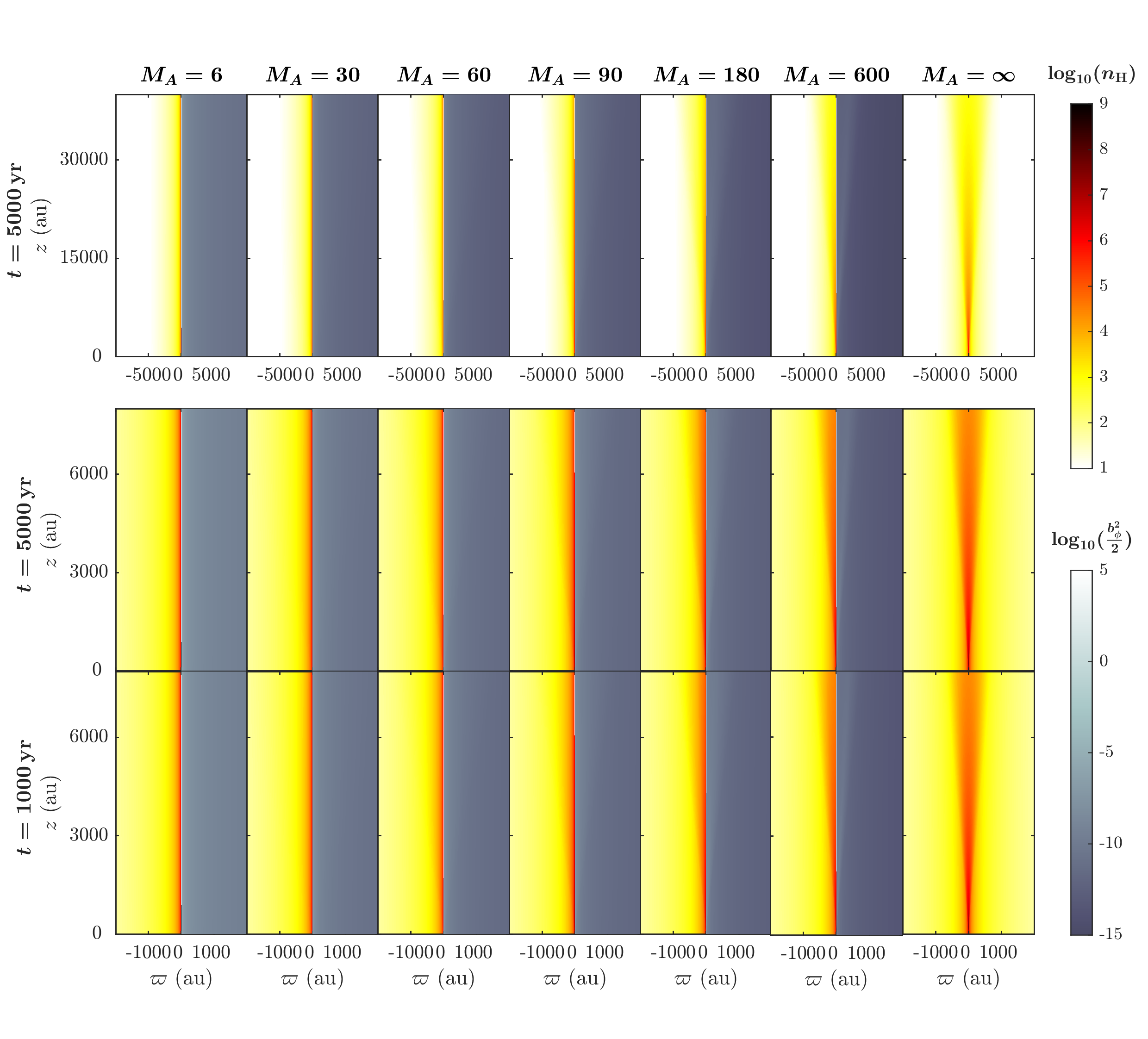
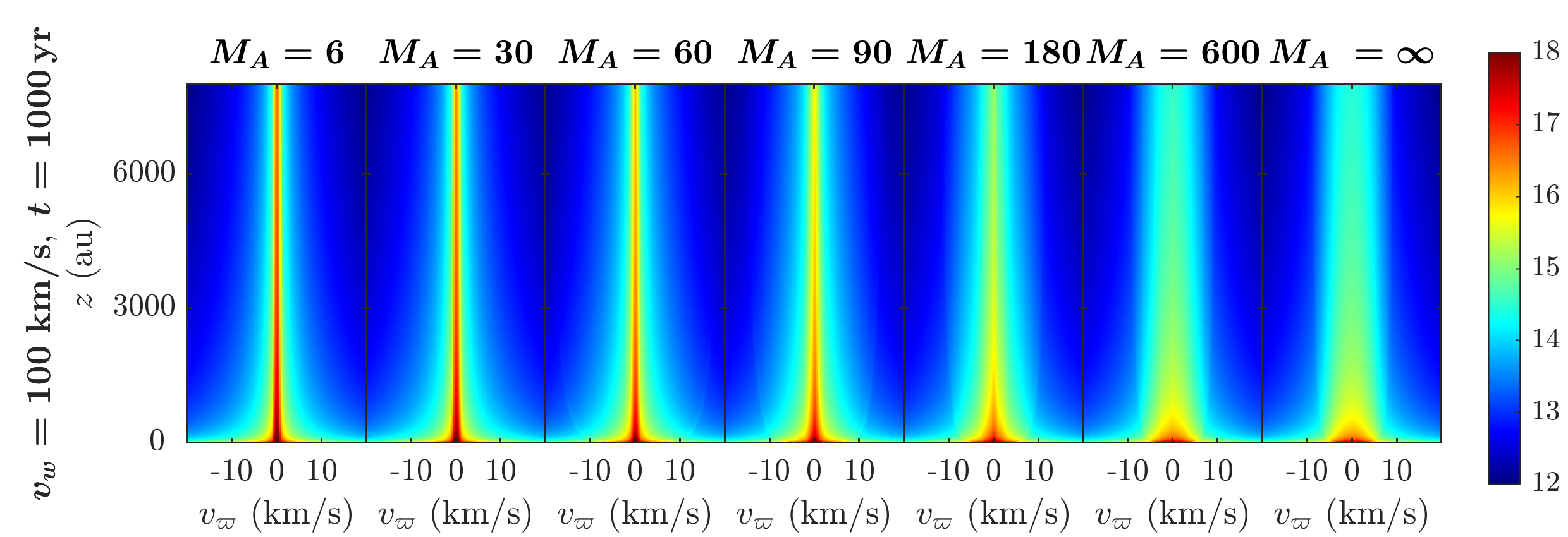
Top: Free-wind simulations snapshots with various MA (6, 30, 60, 90, 180, 600, infinity/non-magnetized) showing profiles of density (left half) and toroidal magnetic pressure (right half). Bottom: Position–velocity diagrams shown in column density logarithmically in units of cm−2 at 90° for the various MA cases. This figure demonstrates the density collimation with toroidal magnetic field strength bφ.
-
Ambient flattening (parameterized by n)

Ambient toroid density (bold contours) and magnetic field structure (thin contours) of various flattening n = 1, 2, 4, 6 from left to right (cf. Shang et al. 2006).
-
Ambient poloidal magnetization (parameterized by αb)
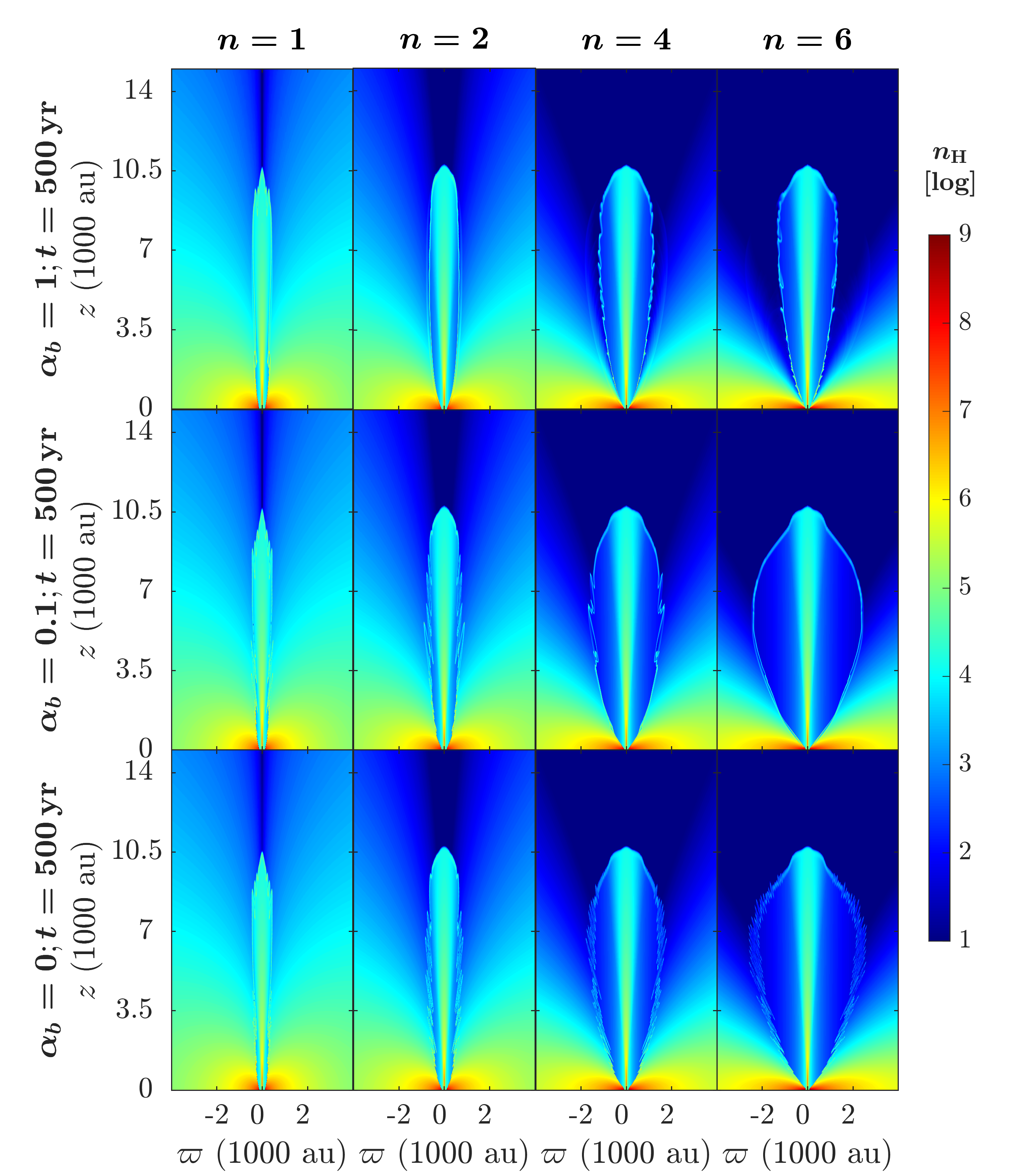
Density distribution of non-magnetized winds interacting with increasing magnetized ambient toroids from bottom to top with αb = 0, 0.1, and 1. The 500-year snapshots of outflows with a nominal wind velocity 100 km/s are shown. The non-magnetized wind and toroid interactions resemble the outflow lobe shapes described in the classical Shu et al. (1991) snow-plowed molecular outflows.
Sample Simulations
Simulations of outflows formed by magnetized winds of speed 100 km/s interacting with various toroid flattening (n = 1, 2, 4, 6) for strong-to-moderate wind magnetization (upper panel; MA = 6, 30) and moderate-to-weak wind magnetization (lower panel; MA = 60, 600) with strong ambient magnetization (αb = 1).
Gallery of Wind-Ambient Interplay Simulation Snapshots
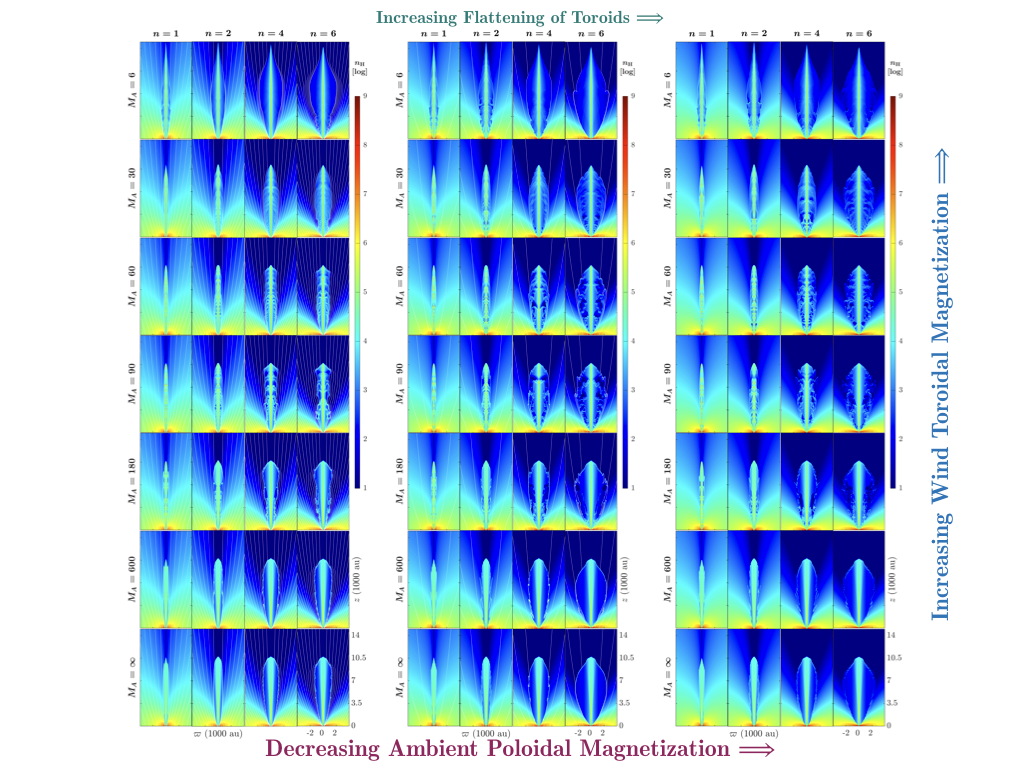
Volumetric number density distributions (logarithmically shown in units of cm-3) of the fiducial outflow cases at 500 years. The three main columns show decreasing degrees of ambient poloidal magnetization of αb = 1, 0.1, and 0. Within each column, the wind magnetization increase from bottom to top of MA = ∞, 600, 180, 90, 60, 30, and 6; ambient toroid opening increases from left to right of n = 1, 2, 4, and 6.
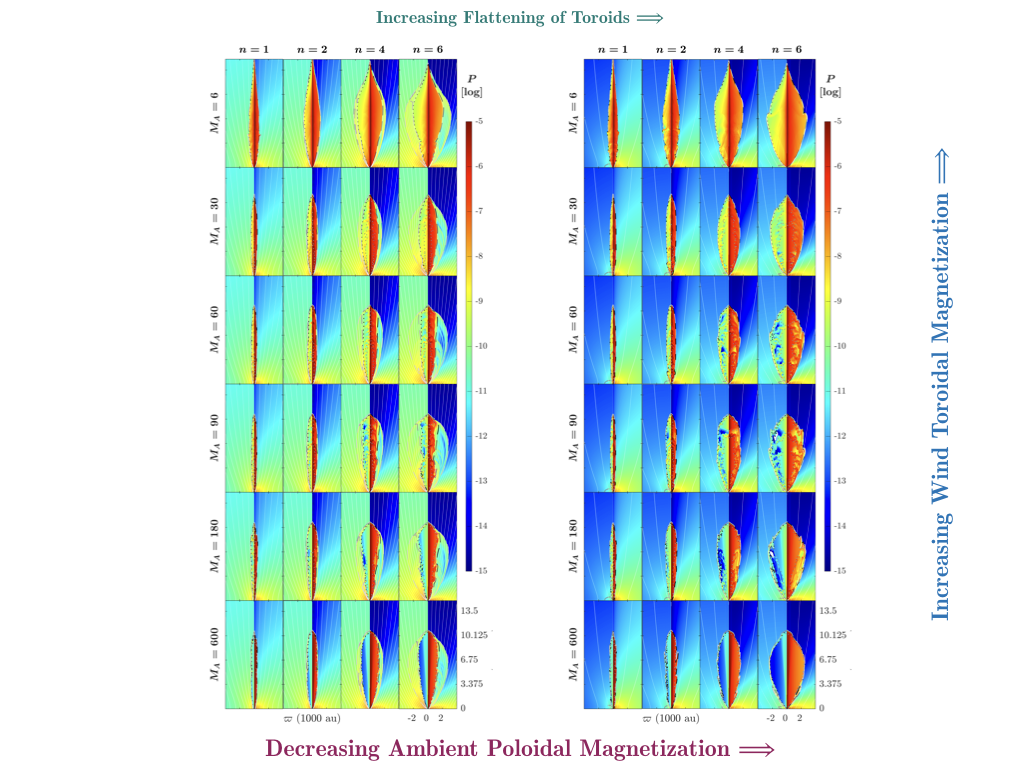
Distributions of total magnetic (poloidal + toroidal) pressure as left halves and ram + gas pressure as right halves of the outflow lobes (logarithmically shown in units of dyn/cm2) at 500 years. The two columns show decreasing degrees of ambient poloidal magnetization of αb = 1 and 0.1. Within each column, the wind magnetization increase from bottom to top of MA = 600, 180, 90, 60, 30, and 6; ambient toroid opening increases from left to right of n = 1, 2, 4, and 6.
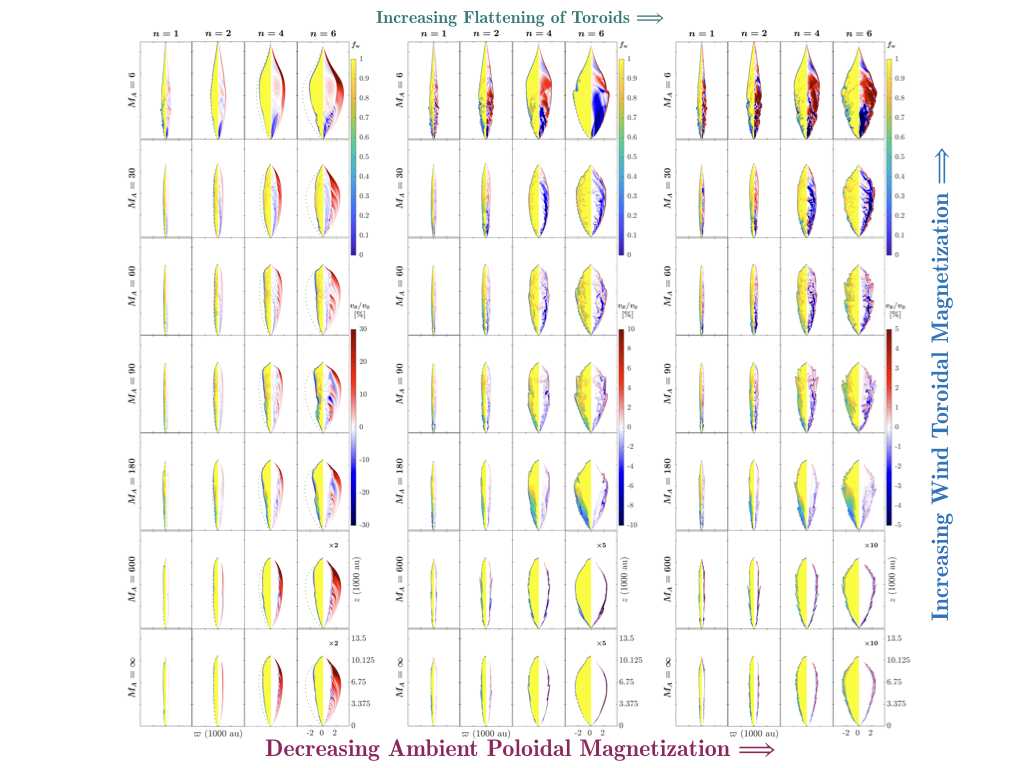
Structures of the magnetized and hydrodynamic mixing layers and spatial correlation with vθ for the fiducial outflow cases at 500 yr. The left halves of the panels consist of spatial variations of the wind mass fraction f and the right halves consist of vθ in percentage of the nominal free-wind speed v0. Outermost dotted contours of vr = aambient are tracing the outer boundaries of the magnetic cocoons in αb = 1 (left column) cases or the outermost shocked ambient shells in αb = 0.1 (center column) and αb = 0 (right column) cases. Within each column, the wind magnetization increase from bottom to top of MA = ∞, 600, 180, 90, 60, 30, and 6; ambient toroid opening increases from left to right of n = 1, 2, 4, and 6.
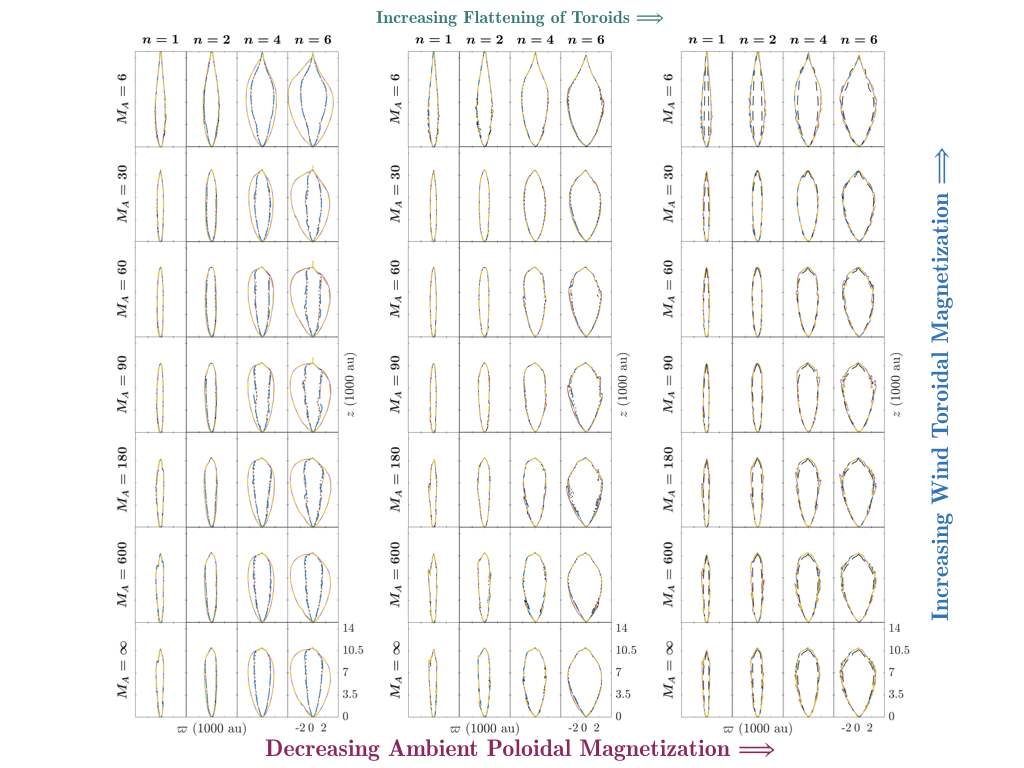
Contours of lobe shapes for αb = 1 (left), 0.1 (middle), and 0 (right). The v0 = 50 km/s cases are plotted on the negative ϖ-axis and v0 = 100 km/s cases are plotted on the positive ϖ-axis around ϖ = 0. The loci of the wind fraction f = 10−4, delineating the shapes of wind lobes, are taken at 1000 yr (red solid lines) and 2000 yr (blue dashed lines) scaled to 1000 yr for the left and at 500 yr (red solid lines) and 1000 yr (blue dashed lines) scaled to 500 yr for the right. The loci of ∣vr∣ = aambient, delineating the magnetic bubbles in strong ambient magnetization cases and forward shocks in weak to no ambient magnetization cases, are taken at 1000 yr (purple solid lines) and 2000 yr (yellow dashed lines) scaled to 1000 yr for left and at 500 yr (purple solid lines) and 1000 yr (yellow dashed lines) scaled to 500 yr for the right. For αb = 1 and 0.1 cases, the loci of magnetic-to-ram-pressure ratio η = (bp2/2 )/(ρvp2) = 0.5 and 0.01 are shown with black dotted lines. For αb = 0 cases, the solutions to momentum-conserving shells are shown with black dashed lines.
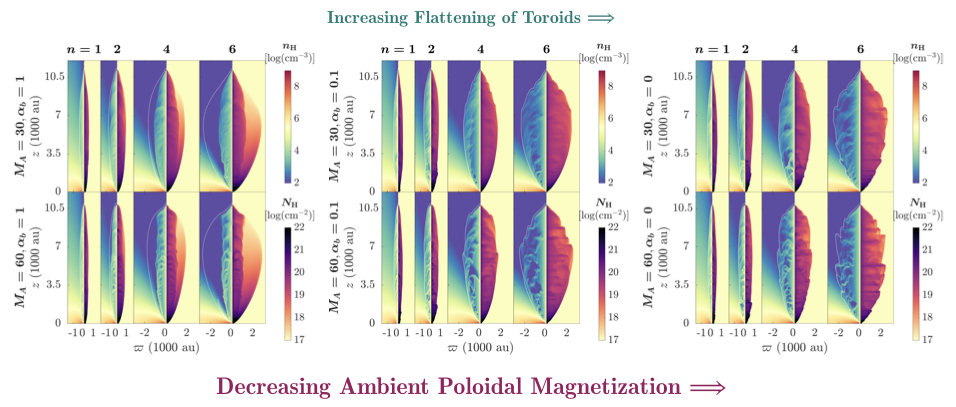
Synthetic observations in the form of column density: profiles produced by mixing structures in moderately magnetized (MA = 30, 60) winds of 100 km/s interacting with n = 1, 2, 4, 6 toroids of αb = 1, 0.1, and 0 at 500 years. For each αb, cases for MA = 30 are shown in the upper portion and those for MA = 60 are shown in the bottom. For each panel, the logarithmic density distribution is shown in units of cm-3 in the left halves, and the column density, including wind (free and compressed) and compressed ambient material by integrating vp > aambient regions, is shown logarithmically in the right halves in units of cm-2.
Related Publications
- Shang H; Krasnopolsky R; Liu C-F; Wang L-Y, “A Unified Model for Bipolar Outflows from Young Stars: The Interplay of Magnetized Wide-Angle Winds and Isothermal Toroids”, ApJ: 905(2), 116, Dec 20, 2020 [SCI] ( ADS | Fulltext )
- Wang L-Y; Shang H; Krasnopolsky R; Chiang T-Y, “A Two-Temperature Model of Magnetized Protostellar Outflows”, ApJ: 815(1), 39, Dec 10, 2015 [SCI] ( ADS | Fulltext )
- Shang H; Allen A; Li Z-Y; Liu C-F; Chou M-Y; Anderson J, “A Unified Model for Bipolar Outflows from Young Stars”, ApJ: 649(2), 845-855, Oct 1, 2006 [SCI] ( ADS | Fulltext )

